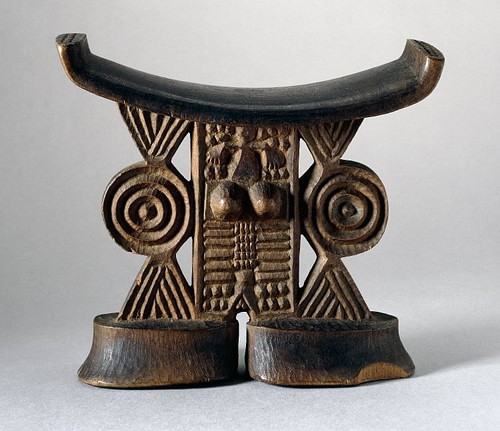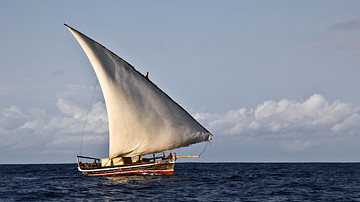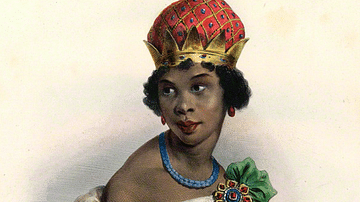The Portuguese first took an interest in East Africa from the beginning of the 16th century as their empire spread eastwards across the Indian Ocean. Trade in the region was already well-established and carried out by Africans, Indians, and Arabs. Attacks on the trading cities of the Swahili Coast and the Kingdom of Mutapa by the Portuguese did not bring any tangible benefits as traders simply moved to the north. Consequently, the Europeans decided to concentrate on the area which became Portuguese East Africa (aka Portuguese Mozambique) further south. Mozambique was settled by Portuguese who integrated with local communities in the country's interior. Mozambique remained a Portuguese colony until independence was achieved in 1975.
Swahili Coast
The Swahili Coast, located on the shores of East Africa, was a region where Africans, Arabs, and Muslim traders mixed to create a unique identity from the 8th century called Swahili Culture. Swahili is the name of their language and means 'people of the coast.' The coast prospered from the 12th to 15th century thanks to its profusion of small islands and natural harbours. 35 independent trading cities like Mombasa, Mogadishu, and Zanzibar established lucrative trade contacts with African tribes in the interior and states across the Indian Ocean such as Arabia, India, and even China. Gold, ivory, tortoise shells, animal hides, and slaves came from Africa’s interior to be traded for Asian goods like silk, spices, incense, Ming porcelain, glassware, coral, and jewellery.
Then, in the final years of the 15th century, the Portuguese arrived to upset this century-old balance of trade. The first momentous move in this game of empires came with the 1498-1499 voyage of Vasco da Gama (c. 1469-1524). The Portuguese explorer had audaciously sailed around the Cape of Good Hope and up the east coast of Africa before sailing east to India. He thus opened up a maritime route between Europe and India, but he had also noted the trade ships laden with valuables anchored in the African Swahili ports.
From 1502, the Portuguese were intent on muscling in on the region’s trade, and they set about sinking ships, destroying cities, and building forts to achieve that goal. The Portuguese had a secondary objective in their attacks in East Africa, and this was to damage the Islamic world in any way possible. The Swahili Coast was very much a Muslim-dominated area of Africa, as noted by the historian P. Curtin: "The Muslim religion ultimately became one of the central elements of Swahili identity. To be a Swahili, in later centuries, meant to be a Muslim" (125).
Those who followed in Vasco da Gama’s wake sought one thing: total control of the Indian Ocean trade network. The Portuguese had superior weapons, and they used them to cause havoc amongst the Swahili city-states whose rivalries (for example, between the sultans of Malindi and Mombasa) prevented them from forming a unified response to this new and deadly threat. Achieving dominance with relative ease in the region, Portuguese settlers and merchants would eventually establish themselves at various points along the Swahili coast such as Malindi, Mombasa, Pemba, Sofala, and Kilwa. Many non-Portuguese traders continued their commerce, too, as the Portuguese found they could not police the entire Ocean, and cooperation proved more lucrative than confrontation.
The Portuguese established colonies in India, notably at Portuguese Goa (1510), which became the capital of the Estado da India (the Portuguese Empire east of the Cape of Good Hope). The Portuguese fully intended to control both sides of the Indian Ocean. As more colonies were established in India, the Swahili Coast was repeatedly attacked from these bases. Already in 1505, the city of Kilwa was blasted into ruins by Portuguese cannons, taken over, and refortified. Fortresses were built along the coast of East Africa, notably at Sofala in 1505, Mozambique Island in 1507, and Shama in 1526.
In 1536, the port of Massawa in the Kingdom of Abyssinia (aka the Ethiopian Empire) was captured. The ruler of Abyssinia was not too upset at the loss as he acquired firearms from the Europeans, which proved useful in his own battles with rival forces in the region. The Portuguese were delighted to find Abyssinia a Christian kingdom and an ally against what seemed an Islamic-dominated East Africa. Things went well at first when, in 1543, the Portuguese helped the Ethiopians defeat the armies of Ahmad ibn Ibrahim al-Ghazi (c. 1506-1543), leader of the Adal Sultanate in the north. Unfortunately, the Jesuit missionaries from Portugal and indigenous Coptic priests in Abyssinia became anything but allies, and a civil war brought about the expulsion of the Europeans.
A much more serious flaw in Portugal’s foreign policy in the region was the total lack of interest in establishing any mutually beneficial trade arrangements with the Swahili cities or interior African kingdoms. The ports the Portuguese held were essentially mere collecting points for commodities. Nor was any lasting form of administration established. The Portuguese merely wanted to extract everything and anything of value at as little cost as possible, preferably zero. As the Portuguese presence grew, so they were able to take an even more aggressive stance against rival traders. Ships were blown out of the water, and trade goods were confiscated. The result of this rapacious policy was that traders moved northwards, and the Swahili coast went into serious decline.
Mutapa
As traders drifted away, the Portuguese then went for the next best thing, which was to find the goods at the source. To this end, in 1530 they took a greater interest in the Kingdom of Mutapa in the far south (modern northern Zimbabwe and southern Zambia). The Bantu-speaking Shona peoples of Mutapa (established c. 1450) had inherited the region’s trade network from its predecessor Great Zimbabwe (c. 1100 - c. 1550). Goods from Mutapa, like gold and ivory, were traded with Sofala, an outpost controlled by the most southern Swahili city of Kilwa. From 1530, the Portuguese tried to establish trade markets (feiras) within Mutapa, but their interference in local affairs, particularly their attempts to spread Christianity, brought them into conflict with the Mutapa rulers. In a familiar tale of colonial interference, the kingdom descended into a period of civil wars. A small number of Portuguese landowners clung onto the garrisoned forts at Sena, Tete, and Zumbo in the Zambezi valley.
Further north, the Portuguese were still causing havoc along the Swahili coast, exploiting the rivalries between cities and capturing Mombasa in 1593. A huge fort, Fort Jesus, was then built at Mombasa, which acted as a regional headquarters for the Portuguese. In 1633, a new strategy was adopted in Mutapa and, with the help of Portuguese settlers who had married local women, the Portuguese took over the kingdom completely. Unfortunately, Mutapa was nowhere near as rich in gold as had been hoped for; this was no Inca or Aztec civilization that their great rival Spain was plundering in the Americas.
The decline in East African trade, the disappointment in the non-existent riches of Mutapa, and the fatal problem of tropical diseases resulted in the Portuguese Crown abandoning its ambitions on the Swahili Coast, and instead, they focused on Mozambique Island located between the Swahili Coast in the north and Mutapa in the south. Batua, another Shona kingdom, took over what was left of Mutapa in 1693.
Portuguese Mozambique
The area of what is today Mozambique was first inhabited by Bantu-speaking people who had arrived in the area as part of the Bantu migration from the 1st to 4th century. The famed Chinese mariner-explorer-trader Admiral Zheng He (aka Cheng Ho, c. 1371-1433) visited Mozambique in the first quarter of the 15th century. Arab traders had settled in the area by the end of that century. Vasco da Gama had stopped to resupply his ships there in 1498, and the Portuguese had no doubt made a record of the coasts’ potential for colonization. The first Portuguese settlers arrived on Mozambique Island from 1506, and a captaincy was created where land was parcelled out for development. The Crown controlled all trade to and from Mozambique, making it an extremely profitable colony. By the mid-16th century, however, it was discovered that Mozambique was not as gold-rich as hoped. There was some trade to be done at a local level, and ivory was a potential earner but proved too difficult to obtain and too bulky a commodity to make huge profits from.
Mozambique became a part of the Estado da India from 1571. Carrack trade ships plied the Indian Ocean regularly between Mozambique and Goa as part of the route known as the carreira da India. As in other Portuguese colonies, many European immigrants were undesirables (degredados), shipped by the authorities to free Portugal of them. These reluctant travellers included convicts, beggars, reformed prostitutes, orphans, and religious dissidents. The coastal towns soon developed European architecture, especially villas, churches, and paved thoroughfares. Meanwhile, many Portuguese moved inland and integrated with local tribes, intermarrying and often adopting the lifestyle and even the appearance of Mozambique Africans. A system developed known as prazo, where African chiefs gave land and trade and tribute rights to Portuguese and Afro-Portuguese, an appointment then formally recognised by the Portuguese Crown. In return, the appointee (a muzungo) had to ensure justice was carried out in his territory, supervise traditional rituals, and approve chiefs of smaller villages in their jurisdiction. To maintain their position, muzungos had a private army of retainers (chicunda) which could number several thousand Africans. By 1637, there were at least 80 prazos, and most acted independently of the weak Portuguese administration at the capital Maputo.

The Dutch attacked many Portuguese colonies in the early 17th century, and Mozambique did not escape. The Dutch East India Company launched raids in 1607 and 1608. The Portuguese did entertain hopes of crossing the African interior and creating a geographical link with Portuguese Angola on the other side of Africa, but the advance of the British from southern Africa northwards ended this dream. Tellingly, both the British and Dutch had superior ships to those of the Portuguese, but there was also a threat from the Omani Arabs of the Persian Gulf who were keen to keep hold of their Red Sea trade routes. The Omani moved in on the Swahili coast and captured Portuguese Mombasa in 1698. The Portuguese briefly recaptured it in the 1720s, but put simply, the Portuguese Empire, a string of trading ports that spanned the globe, was too large to maintain without any significant land occupation to provide local troops to defend it. Following more victories by the Omani, the Portuguese were left with only Mozambique to show for all their efforts on the east coast of Africa.
From 1752, Mozambique became a separate administration from the Estado da India and Goa. The colony’s governor was now responsible to Lisbon directly. The slave trade grew from Mozambique in the mid-18th century as demand boomed for slaves to work on the French sugar plantations on Reunion and Mauritius. In the 19th century, there was more settlement of the interior and much exploration by scientists as Mozambique became a full territorial colony and not merely a strip of coastal strongholds and disconnected interior estates.
While some private traders prospered, the Portuguese Crown did not gain very much from Mozambique in the end. Indigenous resistance and a marked preference by Portuguese migrants for a colony like Portuguese Brazil meant that the Portuguese Crown abandoned attempts at direct control and instead gave out swathes of the region to private companies to develop from 1891. One such company was the Niassa Company which ruthlessly confiscated agricultural surpluses from the indigenous farmers. Another was the Mozambique Company that grabbed slaves for use on colonial sugar plantations. In the late 19th century, the colony officially became Portuguese East Africa.
Not surprisingly, the lack of a centralised authority gave hope to the people of Mozambique that they might fight for their freedom. A major uprising broke out in 1917, the Barwe rebellion, and a German force invaded northern Mozambique in the same year. The Portuguese clung on, and Mozambique was made an overseas province of Portugal in 1951. A new independence movement began in 1962, and autonomy from colonial rule was finally achieved in 1975 after a long period of repressive government policies and guerrilla warfare. A civil war then ravaged the country until 1992.








